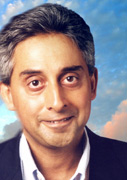
EVERY TIME THOSE SMUG FELLOWS in first class spy me luxuriating in economy, they turn green. Not because I defy every law of physics by squeezing an ungodly mass into an impossibly small thimble of space, with limbs contorted like a human Rubik’s Cube. Nor because they know how enjoyable it is in the back where stewardesses zap you with a cattle prod if you dare ask for a blanket again.
They’re green because frequent flying involves large doses of cosmic radiation. Rubik’s Cube passengers tend to fly less frequently perhaps because it can take a while to unravel the limbs and get around to filling out those immigration forms. Let me enlighten you. The radiation dose from a transatlantic flight is about the same as one simple chest x-ray. In other words you can fly ten times back and forth across the pond or you can have ten chest x-rays with pretty much the same radiation dose. It strikes me, however, that the latter option is both cheaper and less time consuming. Had I known about this earlier I would have spent more time with my doctor. Why waste money on the Eiffel Tower when you could gape at your oesophagus at a fraction of the price?
Send us your Feedback / Letter to the Editor
 Share This Page Share This Page
Don’t get me wrong. Simply standing on the ground back on Planet Earth will still get you fried. This is because of something known as “natural background radiation” which is essential for life and health. The culprits include sunlight, certain minerals, radon gas, holidays in the Bikini Atoll, North Korean cooling rods, made-in-Chernobyl products, and so on. Cosmic radiation from solar and galactic activity (not counting the Star Wars prequels) accounts for about 17 percent of your total dose, with ambient radon gas providing around 50 percent, minerals 20 percent and, hear this, internal body radiation from food and water consumed contributing 13 percent. Think of that next time you kiss someone.
Standing innocently on the ground will still get you fried. This is because of something known as 'natural background radiation'
Cosmic radiation follows an 11-year cycle of highs and lows (2001 was the last trough) and is most pronounced at the Earth’s poles. For some reason, cosmic radiation levels at the equator are three times less than at the poles. The good news for frequent fliers is that serious radiation only kicks in after 30,000ft where the atmosphere is too thin to safely disperse or absorb the heavenly bombardment. And 30,000ft to 40,000ft is exactly where commercial jets like to hang around.
According to the Canadian health authorities (and they’re close enough to the North Pole to know), “Even though exposure can be a hundred times greater at these altitudes than it is on the ground, it is still fairly small. It would take about 100 one-way flights between Toronto and Vancouver to obtain the same exposure as we get in one year from other sources of natural background radiation.” What they forget to mention is that anyone doing 100 one-way flights between Toronto and Vancouver would have to have their head examined – with a heavy duty CAT scan.
The history of radiation reads like a suspense novel:
- 7 April, 2000, a solar pulse triggers unprecedented aurora borealis.
- 13 July, 2000, solar “eruption” causes massive radio blackouts.
- 1 April, 2005, Vijay Verghese straps Samsung microwave around his chest and threatens to nuke – and overcook – his lunch, a lamb kebab, unless airlines give in to demands for cheaper fares and larger seats.
Another great way to get around inflight radiation is to marry a tightwad who doesn't permit you to travel...
Radiation levels are measured in a unit called sieverts, usually expressed in millisieverts (a thousandth of a sievert) or microsieverts (a millionth of a sievert). To give you a general idea of what this all means, on average, residents of the UK are exposed to background radiation amounting to 2.6mSv (millisieverts) each year against a recommended limit of 1mSv per annum which, according to British Airways, “equates to about 200 hours flying per year on subsonic trans-equatorial routes.”
You can’t get away from radiation. Some everyday items that produce 100 to 400 becquerels (a unit of radioactivity) per kilogram, are: cereals, poultry (so it’s not just bird flu you need to watch out for), green vegetables, concrete, sand and drinking water. And to get a dose of over 400 becquerels per kilogram, take on tea, coffee, shellfish, and Brazil nuts. Or fertilizer (but don’t eat it).
If you want to fight fire with fire, or food with food, counter radiation with vitamin C, vitamin E and selenium. Other foods working indefatigably to rid your body of toxins include whole grains, apples, grapes, the lowly cabbage and Japanese miso soup. Also recommended are saunas, steam, and a long soak in a hot bath mixed with a cup each of baking soda and sea salt.
Another great way to beat radiation is to marry a tightwad who never lets you travel. But wait – is that a packet of Brazil nuts in your hand..?
Send us your Feedback / Letter to the Editor |